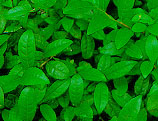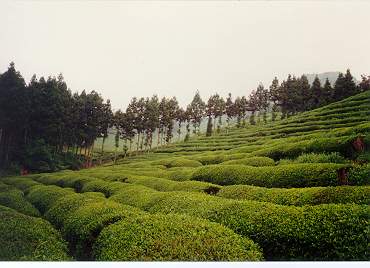...previous
page
Making tea in Korea

After the loss of Korea's tea culture in the
14th century, tea trees continued to grow wild in the southern
regions, especially on the lower slopes of Chiri mountain.
These self-propagated bushes provided the leaves used by those
few people still aware of their value. Tea does not grow north
of Chonju and not on every kind of soil to the south. In recent
years additional bushes have been planted on the slopes of
Chiri-san, and other southern hills, but without the creation of
large artificial tea plantations. The finest tea is that grown
in complete harmony with nature and with limited use of
fertilisers or insecticides.
 Tea plantations
Tea plantations of a more intensive kind, with the bushes
planted in neat rows and operated on an industrial scale, have
been established in various areas, the most important being
those found in Posong near Kangjin; other large industrial
tea-plantations can be found on the slopes of Wolch'ul-san, also
in the south-west, and and in the island of Cheju-do. The Posong
plantation pictured here produces the tea known as Yubi-ch'a. Click
here for some more (rather romantic) photos of the Posong
tea fields, which have become a popular tourist spot.
of a more intensive kind, with the bushes
planted in neat rows and operated on an industrial scale, have
been established in various areas, the most important being
those found in Posong near Kangjin; other large industrial
tea-plantations can be found on the slopes of Wolch'ul-san, also
in the south-west, and and in the island of Cheju-do. The Posong
plantation pictured here produces the tea known as Yubi-ch'a. Click
here for some more (rather romantic) photos of the Posong
tea fields, which have become a popular tourist spot.
The remaining photos on this page were taken in Chiri Mountain
and show the making of Panyaro Tea by the great Tea Master Chae
Won-hwa.
 Tea can only be made using the
fresh tips, the scarcely opened buds that start to grow in early
April. Once a leaf is fully developed, it is soon too
coarse for use. After late May the bushes may continue to
produce further shoots but these no longer have the intense
flavour needed for good tea. Therefore all the green tea needed
for the year has to be plucked and made in less than two months.
The very earliest buds have the finest flavour, and are the most
difficult to collect, especially if the winter frosts last late.
Tea can only be made using the
fresh tips, the scarcely opened buds that start to grow in early
April. Once a leaf is fully developed, it is soon too
coarse for use. After late May the bushes may continue to
produce further shoots but these no longer have the intense
flavour needed for good tea. Therefore all the green tea needed
for the year has to be plucked and made in less than two months.
The very earliest buds have the finest flavour, and are the most
difficult to collect, especially if the winter frosts last late.
The different
grades of green tea
The Korean calendar has twenty-four seasonal
dates based on the movement of the sun, which it borrowed from
Chinese tradition; the day known as Kok-u normally
falls on April 20. The tea gathered before this date is known as
Ujon and commands the highest price. The next
seasonal date Ipha falls on May 5-6, and tea
gathered between those two dates is known as Sejak.
Tea gathered after Ipha is known as Chungjak.
These names (also of Chinese origin) often figure on the menus
in tea-rooms, to the mystification of the uninformed public. It
should also be added that the Korean weather is colder than that
in China, with the result that Korean tea-makers, although they
pay lip-service to the traditional dates, actually go on making
'Ujon' from the first growth of shoots way beyond April 20, when
very often there are no new shoots on the tea bushes. The
earlier the tea, the more delicate the taste and the cooler the
water should be in making it, with many authorities recommending
that the water for Ujon should be cooled down to 50
degrees.
How green tea
is dried
 The gathering of leaves
requires skill and speed. It is done mostly by the women of the
region, who can only collect a few pounds of leaves in the
course of a day. The drying of the leaves into tea for drinking
must be done within twenty-four hours of picking, before the
juices in them start to oxidize. In Korea as in Japan, the
easiest, industrialized method of drying green tea
involves the use of a revolving drum in which the leaves are
dried by a flow of hot air as the drum turns.
The gathering of leaves
requires skill and speed. It is done mostly by the women of the
region, who can only collect a few pounds of leaves in the
course of a day. The drying of the leaves into tea for drinking
must be done within twenty-four hours of picking, before the
juices in them start to oxidize. In Korea as in Japan, the
easiest, industrialized method of drying green tea
involves the use of a revolving drum in which the leaves are
dried by a flow of hot air as the drum turns.
There are two main methods of hand-drying in
use in Korea when making the best green tea. The way of drying
resulting in what is known as Puch'o-ch'a is much
more common; the fresh leaves are first tossed in a very hot
iron cauldron over a wood or (now more often) a gas fire, being
stirred constantly to prevent burning. This softens them. Then
the leaves are removed from the heat to be rubbed and rolled
vigorously on a flat surface, so that they curl tightly on
themselves. They are then returned to a less intense heat, and
the process is repeated a number of times, traditionally nine
times, until the leaves are completely dry.

With the tea known as Chung-ch'a,
represented by Panyaro tea, the fresh leaves are plunged for a
moment into nearly boiling water (left), then allowed to
drain for a couple of hours, before being placed over the fire.
Chung-ch'a is much commoner in Japan than in Korea
but after the initial stage there is little or no similarity in
the way of making the tea. The resulting teas are completely
different in color, taste and fragrance.

With Chung-ch'a the drying and rolling
are done concurrently, the leaves are not removed from the heat
until they are completely dried, after about two hours. During
this time, the leaves are constantly turned, rubbed, and pressed
to the bottom of the cauldron. The drying has to be completely
regular and at the same time no leaf must burn. An intense
fragrance emerges from the leaves as the drying advances.

This means that the people stirring and
rubbing the leaves between their (gloved) hands to roll them are
obliged to sit directly over the cauldron on its fire. Not
surprisingly, this tea, which has by far the finest fragrance,
is very expensive. It takes many years of experience to know
just when to stop the drying; tea which is removed from the fire
too quickly still contains moisture that can cause it to go
mildew after a few months.
 (Pictures) Chae Won-hwa takes
charge of operations during the last 30 minutes or so. She
decides when the time has come to take the tea from the fire.
(Pictures) Chae Won-hwa takes
charge of operations during the last 30 minutes or so. She
decides when the time has come to take the tea from the fire.
 She takes the tea into a
store-room which no one else is allowed to enter. She explains
that there she prays over the tea, and does whatever else is
needed to give her Panyaro tea its remarkable intensity of
flavour. She insists that when she has chosen someone to be her
authorized successor, she will instruct that person in these
final mysterious rites. It is important that the dried tea
leaves remain in a very warm, dry place until they are packed in
air-tight containers, so that the drying continues.
She takes the tea into a
store-room which no one else is allowed to enter. She explains
that there she prays over the tea, and does whatever else is
needed to give her Panyaro tea its remarkable intensity of
flavour. She insists that when she has chosen someone to be her
authorized successor, she will instruct that person in these
final mysterious rites. It is important that the dried tea
leaves remain in a very warm, dry place until they are packed in
air-tight containers, so that the drying continues.
The main difference between green tea
and the kinds known as oolong or red (in
English black) lies in the lack of oxidation,
also known inaccurately as fermentation. If the juices
and enzymes within the leaves are allowed to oxidize, their
surfaces having been bruised by initial cold rolling, and the
final drying delayed by several hours, the result will be an
immense variety of tastes quite unlike green tea.
Click to go on to the next
page or back to
the Index
 Tea plantations
Tea plantations of a more intensive kind, with the bushes
planted in neat rows and operated on an industrial scale, have
been established in various areas, the most important being
those found in Posong near Kangjin; other large industrial
tea-plantations can be found on the slopes of Wolch'ul-san, also
in the south-west, and and in the island of Cheju-do. The Posong
plantation pictured here produces the tea known as Yubi-ch'a. Click
here for some more (rather romantic) photos of the Posong
tea fields, which have become a popular tourist spot.
of a more intensive kind, with the bushes
planted in neat rows and operated on an industrial scale, have
been established in various areas, the most important being
those found in Posong near Kangjin; other large industrial
tea-plantations can be found on the slopes of Wolch'ul-san, also
in the south-west, and and in the island of Cheju-do. The Posong
plantation pictured here produces the tea known as Yubi-ch'a. Click
here for some more (rather romantic) photos of the Posong
tea fields, which have become a popular tourist spot. 






